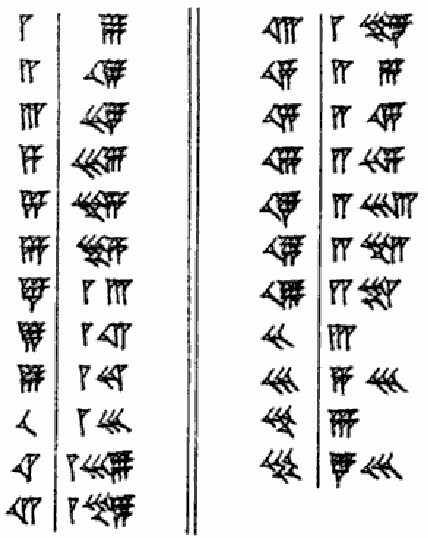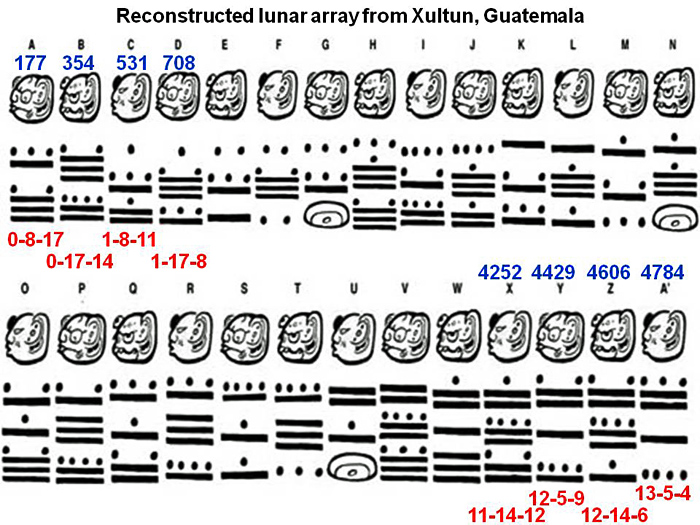- Your quiz this week will feature Egyptian Mathematics, and using Pascal's triangle to count things or to compute probabilities.
- We continued with more examples of Egyptian division.
We did some of the divisions in a way analogous to the multiplication table; we also used the "Unit Fraction Table" to find the same answers, relying in part on the "Fraudini trick".
- $\displaystyle
\frac{6}{7}=\frac{4+2}{7}=\frac{4}{7}+\frac{2}{7}
=2\frac{2}{7}+\frac{2}{7} $
so we look up $\frac{2}{7}$ in the Unit Fraction Table, and find that $\frac{2}{7}=\frac{1}{4}+\frac{1}{28}$. Therefore,
\[ \displaystyle \frac{6}{7}= 2*(\frac{1}{4}+\frac{1}{28})+\frac{1}{4}+\frac{1}{28}= \frac{1}{2}+\frac{1}{14}+\frac{1}{4}+\frac{1}{28} \]
- $\displaystyle
\frac{6}{7}=\frac{4+2}{7}=\frac{4}{7}+\frac{2}{7}
=2\frac{2}{7}+\frac{2}{7} $
- Here's a relatively easy one: Suppose Fatima had 3
loaves to share between 4 people. How would she
do it? (Think about what the answer means, in
terms of bread, and keeping kids happy.)
- Let's try this one:
- How would you divide 5 by 9?
(Start with halves, and then what?)
- How can we use the Fraudini trick and the
Unit
Fraction Table to get the answer?
- (Is it possible to get two different answers?)
- How would you divide 5 by 9?
- Near the end of class we had a look at Babylonian
mathematics, in particular an object (clay tablet)
which turned out to be a times table. Some actual
clay tablets and their translations are here.
What did we learn about the Babylonian system? (Other than that they were partiers, who liked martinis and playing with boomerangs at the beach?:)
We're going to do three things today: solve two mysteries, and celebrate our hero Zero.
- How do you like this t-shirt?

You should be ready to get the joke. And I'm hoping that, by the end of the day, you'll have come up with some more joke shirts!
- We begin by playing Sherlock Holmes in Babylon
The author, Prof. Buck, guesses that "the document" (actually a clay tablet) comes from the city of Nippur, in what is now Iraq:

Buck says this "Confronted with an artifact from an ancient culture, one asks several questions:
- What is this and what are its properties?
- What was its original purpose?
- What does this tell me about the culture that produced it?
Your job: to describe the markings, and investigate the patterns on this tablet.
- What can we deduce about
- the purpose of the table?
- the way (and reason) Babylonians wrote their numbers the way they did?
- the Babylonians and place value?
- the Babylonian's missing number(s)?
- the Babylonian influence in our world today?
- How many digits did the Babylonians have?
- How would the Babylonians write these numbers:
- 47
- 573
- 1, 60, and 3600
- One thing to note: the Babylonians blocked into
threes. You don't see a line of 9 martini glasses. They knew
that by blocking -- making rock groups -- the digits they wrote
would be easier to recognize.
- What do you think of my new t-shirt?
- The frequently unsung hero of the Hindu-Arabic numbers is
the digit 0 -- a symbol for nothing!
(The Babylonians can't distinguish the numbers 1 from
60, without some additional context -- they had no hero).
Well let it be unsung no more! I hope that you'll enjoy this rendition of
(favorite lyrics: "et cetera, et cetera; ad infinitum; ad astra1; forever and ever")
- Now to the mystery of the Mayans....

Same questions:
- What can we deduce about
- the Mayans and place value?
- the purpose of the table?
- the way Mayans looked at numbers and their world?
- the Mayan influence in our world today?
- How would the Mayans write these numbers:
- 47
- 573
- 3600
- 14001
- What can we deduce about
- Do math like an Egyptian! (Walk Like An Egyptian/Michael Jackson Mash-up!)
- Hexagonal Paper
- Pascal's triangle (wikipedia)
- American Bandstand dances to Gimme Some Lovin', a hit by The Spencer Davis Group: here's their version.
- List of musical works in unusual time signatures
- Blue Rondo a
la Turk, by Dave Brubeck: illustrating
how to play a piece in 9/8.
Watch Dave Brubeck's leg, counting out the rhythm....